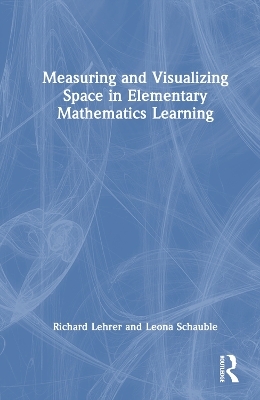
Measuring and Visualizing Space in Elementary Mathematics Learning
Seiten
2023
Routledge (Verlag)
978-1-032-26273-4 (ISBN)
Routledge (Verlag)
978-1-032-26273-4 (ISBN)
This book explores the development of elementary students’ understanding of the mathematics of measure, and demonstrates how measurement can serve as an anchor for supporting a deeper understanding of number operations and rational numbers. It is relevant for scholars, teacher educators, and specialists in math education.
Measuring and Visualizing Space in Elementary Mathematics Learning explores the development of elementary students’ understanding of the mathematics of measure, and demonstrates how measurement can serve as an anchor for supporting a deeper understanding of number operations and rational numbers.
The concept of measurement is centrally implicated in a number of mathematical operations, yet is not often given the placement it deserves in the elementary mathematics curriculum. By drawing on K-5 classroom research, authors Lehrer and Schauble have been able to articulate a learning progression that describes benchmarks of student learning about measure in length, angle, area, volume, and rational number, exploring related concepts, classroom experiences, and instructional practices at each stage.
Offering a unique, research driven resource for helping students develop a deep understanding of measurement to further enhance mathematical understanding, as well as further learning in other STEM disciplines; the book will be relevant for scholars, teacher educators, and specialists in math education.
The book is accompanied by online resources developed for practitioners, including instructional guides, examples of student thinking, and other teacher-focused materials, helping clarify how to bring concepts of measure and rational number to life in classrooms.
Measuring and Visualizing Space in Elementary Mathematics Learning explores the development of elementary students’ understanding of the mathematics of measure, and demonstrates how measurement can serve as an anchor for supporting a deeper understanding of number operations and rational numbers.
The concept of measurement is centrally implicated in a number of mathematical operations, yet is not often given the placement it deserves in the elementary mathematics curriculum. By drawing on K-5 classroom research, authors Lehrer and Schauble have been able to articulate a learning progression that describes benchmarks of student learning about measure in length, angle, area, volume, and rational number, exploring related concepts, classroom experiences, and instructional practices at each stage.
Offering a unique, research driven resource for helping students develop a deep understanding of measurement to further enhance mathematical understanding, as well as further learning in other STEM disciplines; the book will be relevant for scholars, teacher educators, and specialists in math education.
The book is accompanied by online resources developed for practitioners, including instructional guides, examples of student thinking, and other teacher-focused materials, helping clarify how to bring concepts of measure and rational number to life in classrooms.
1. Measure is Fundamental 2. The Context, Goals, and Design of the Research 3. Origins of Quantitative Reasoning in the Measure of Length 4. Creating New Quantities in the Dynamic Generation of Area 5. Extending Motion to Three Dimensions: Volume and Its Measure 6. Integrating Figure and Motion in the Measure of Angle 7. Measurement Models of Arithmetic Operations and Rational Number 8. Highlights of Student Learning Research 9. Teacher Learning 10. Measures and Models in Elementary Science
| Erscheinungsdatum | 15.03.2023 |
|---|---|
| Zusatzinfo | 26 Tables, black and white; 98 Line drawings, black and white; 98 Illustrations, black and white |
| Verlagsort | London |
| Sprache | englisch |
| Maße | 152 x 229 mm |
| Gewicht | 480 g |
| Themenwelt | Geisteswissenschaften ► Psychologie ► Allgemeine Psychologie |
| Geisteswissenschaften ► Psychologie ► Verhaltenstherapie | |
| Mathematik / Informatik ► Mathematik | |
| Sozialwissenschaften ► Pädagogik ► Schulpädagogik / Grundschule | |
| ISBN-10 | 1-032-26273-7 / 1032262737 |
| ISBN-13 | 978-1-032-26273-4 / 9781032262734 |
| Zustand | Neuware |
| Informationen gemäß Produktsicherheitsverordnung (GPSR) | |
| Haben Sie eine Frage zum Produkt? |
Mehr entdecken
aus dem Bereich
aus dem Bereich
Techniken der Verhaltenstherapie
Buch (2024)
Julius Beltz GmbH & Co. KG (Verlag)
CHF 48,95


